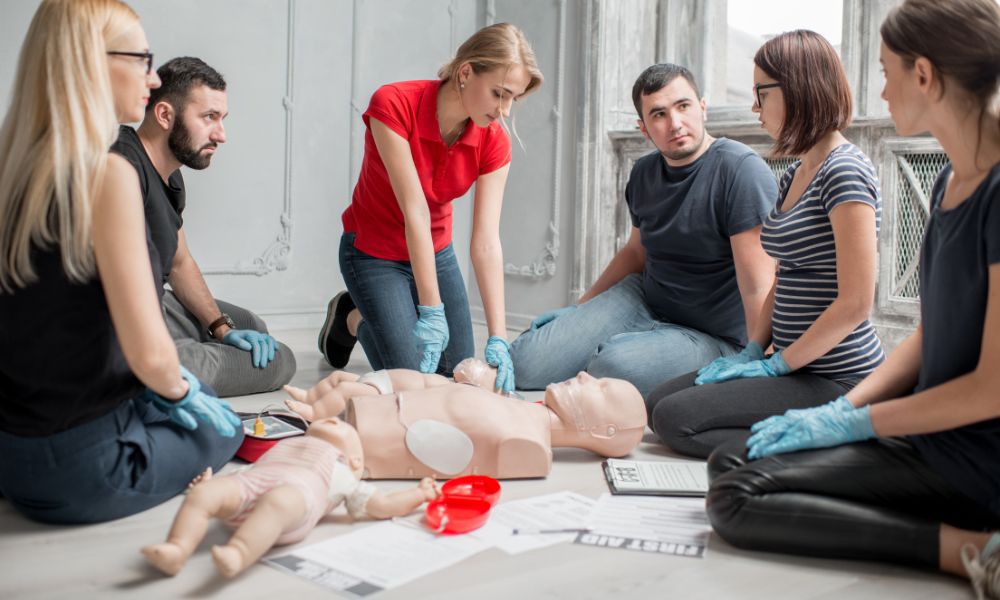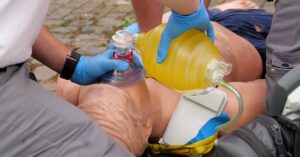The outcome of an emergency depends greatly on the speed and efficacy of the initial response. Traditional CPR has been the cornerstone of emergency care, but a new method known as Hands-Only CPR has proven effective as well. The rise of this new technique has been met with many questions, including which method is more effective. This and other probing questions are all answered here to educate healthcare and non-healthcare professionals alike.
The Difference in Methods
To compare the effectiveness of Hands-Only CPR and traditional CPR, we need to first understand them and what they entail.
Traditional CPR in Detail
Traditional CPR combines chest compressions with rescue breaths, typically in a ratio of 30 compressions to two breaths. It is an intense process that involves clearing the airway, tilting the head back, and ensuring that the chest rises with each breath.
The Simplicity of Hands-Only CPR
Hands-Only CPR, as the name suggests, only involves chest compressions. The process simplifies the process and encourages bystanders to act more swiftly in emergencies, especially if they’re hesitant about traditional CPR steps and have little to no training.
The Effects of Traditional CPR
Each method has its unique impact on the patient’s body, and understanding these effects is crucial for any emergency response training.
Physiological Response to Traditional CPR
Traditional CPR, with its combination of chest compressions and rescue breaths, circulates oxygen throughout the body, which is essential for victims of cardiac arrest. Compressions also help maintain blood flow to the brain and vital organs.
Increased Potential for Revival
Beyond oxygen circulation and blood flow maintenance, traditional CPR has the added benefit of potentially increasing the chances of revival before professional medical assistance arrives. Integrating rescue breaths can offer a more comprehensive emergency response, particularly in cases of prolonged oxygen deprivation. This combination of compressions and breaths can be crucial for sustaining life in critical moments.
Mitigating Brain Damage
An often-overlooked benefit of traditional CPR is its ability to mitigate brain damage. Using a sequence of chest compressions and rescue breaths helps move oxygen-rich blood to the brain. Doing this can prevent long-term neurological damage. In scenarios where every second without oxygen can lead to significant brain injury, performing traditional CPR is crucial.
The Effects of Hands-Only CPR
Traditional CPR has become an essential skill for all to know. Hands-Only CPR takes this knowledge and transforms it into an even easier practice in an effort to encourage hesitant bystanders to participate in this life-saving technique.
Hands-Only CPR’s Viable Impact
The singular goal of Hands-Only CPR is to keep blood circulating through the chest. This simplified approach is easier to teach and remember, leading to a wider pool of potential lifesavers in the community.
Reduced Hesitation Among Bystanders
Another significant effect of Hands-Only CPR is its potential to reduce hesitation among bystanders. The apprehension associated with performing rescue breaths, often due to fears of doing it incorrectly, concerns about disease transmission, or discomfort with the physical closeness required, can be a barrier to action. By eliminating the need for mouth-to-mouth breathing, Hands-Only CPR makes it simpler to offer help.
Streamlining Emergency Response Training
The streamlined approach of Hands-Only CPR not only makes it more accessible to the general public but also has the potential to simplify emergency response training programs. By focusing on chest compressions alone, training sessions can be shorter and more focused, allowing participants to gain confidence and proficiency more quickly. This efficiency in learning can lead to a larger number of prepared individuals acting in emergencies and improve the effectiveness of community-wide response efforts in saving lives.
The Pros and Cons of Hands-Only CPR
While simplicity is one of the primary benefits of Hands-Only CPR, it does come with both advantages and potential drawbacks.
The Pro: Anyone Can Do It
One of the most significant benefits of Hands-Only CPR is that with minimal training, anyone perform it. Bystanders can react immediately to someone going into cardiac arrest. Learning this method also doesn’t require going through a traditional CPR course.
The Con: A Potential Lack of Ventilation
However, the absence of rescue breaths in Hands-Only CPR means that vital oxygen is not being supplied to the patient, potentially prolonging the brain’s time without oxygen and causing long-term detrimental effects.
The Pros and Cons of Traditional CPR
Traditional CPR remains the more comprehensive technique, which comes with its benefits and challenges as well.
The Pro: Oxygenation of the Body
A significant advantage of traditional CPR is it includes rescue breaths. Delivering oxygen into the patient’s system prevents brain damage and organ failure, particularly if emergency services are not immediately available.
The Con: Perceived Complexity
The most substantial drawback of traditional CPR is that cardiac arrest victims do not typically receive this kind of aid from bystanders, which is often due to the technique’s complexity. A lack of knowledge from bystanders leads to hesitation or reluctance to assist.
What Makes Both Methods Important?
Both Hands-Only and Traditional CPR have their unique roles in emergencies. It might not be a matter of one being better than the other, but rather how a person or group strategizes applying these methods to improve survival odds.
Hands-Only CPR in a Pinch
Hands-Only CPR is revolutionary in that it makes emergency response more accessible to the general public. With its focus on rapid initiation, this method can offer immediate aid until professional medical help arrives.
Traditional CPR for Professional Care
The complexity of traditional CPR, while a barrier for many bystanders, is exactly why it is crucial in a hospital or clinical setting. Trained healthcare professionals can perform it with precision, accompanying the patient’s needs and providing life support.
CPR Certification Is as Easy as 123
Assessing the efficacy of Hands-Only vs. Traditional CPR is a matter of context and application. Both methods have proven to be effective in different situations, and the wider public’s ability to understand and apply these procedures is a significant step towards enhancing community safety.
If you’re inspired to learn more about CPR and first response techniques, consider taking an American Heart Association online course through CPR123. No matter which method you lean towards, knowing how to methodically apply them in various situations is a skill we should all share. Moreover, your knowledge and quick thinking in an emergency could make a critical difference in someone’s life.








